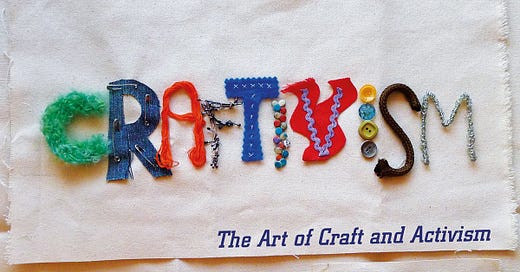Craftivism: Slow and Small and Quiet = Powerful
Most creative ideas need time to simmer, to marinate, to develop organically into what they’re meant to become ... even though it can feel challenging to let that happen
This summer, I’m doing a deep dive into reading all about craftivism. Of course, I’ve read a lot about it here and there over the last decade-plus, especially when I was deeply immersed in full-time writing about the healing benefits of crochet. I always read articles about it that cross my path and I’ve read at least portions of some of the books that are out there but now I’m diving deep and focusing.
Naturally, I’m starting out with Craftivism: The Art of Craft and Activism edited by Betsy Greer, also known as “the godmother of Craftivism” (sometimes the mother or even the grandmother but I usually see and prefer godmother, though I don’t know what she prefers, if anything.) What struck me immediately as I just began the introduction that she wrote is how intentional, slow, meandering, small, quiet, her initial work in this world was.
She explains that in the fall of 2000, she was at a Halloween Parade where there were large Gore/Bush puppets and how everyone was rowdy before and after but fell silent as they passed. She writes, “
“There was something in that schism between the loud and the quiet that spoke to me.” … “I had always thought that activism had to be loud and in-your-face.”
She didn’t do anything with that thought immediately. Instead, she let the idea gel over months, often with thoughts coming to her while knitting, exploring the idea of how craft could be part of “quiet activism,” considering what “quiet activism” might be.
Months passed and eventually she mentioned the idea in a knitting group, to which another member responded that she could call it “craftivism.” She wrote it down in an online journal. That was it for then, the thoughts continued emerging.
It wasn’t until 2002 when she used the word more formally in a research proposal. And it wasn’t until 2003 that she bought the craftivism.com domain name and started writing about it in this public-facing way.
Sometimes, I think, it feels like the second that we have a creative idea, we must develop it, package it, put it out into the world, brand it, monetize it … And while certain ideas work well this way, most creative ideas need more time to simmer, to marinate, to develop organically into what they’re meant to become.
So I love reading about how this big movement, craftivism, that I see as such a powerful tool in the world, began with just a passing thought, developed unintentionally during hours of knitting, added to by a small group of trusted people, begun slowly. Eventually, there is a need for purpose and intention and writing books about the thing … but first, the thing must have space to grow.
I came to craftivism in the 20-teens, so about a decade after Greer had launched the idea. And for me, craftivism projects have always seemed huge. I describe them most often as “large-scale collaborative fiber art projects” and think of them as having dozens, if not hundreds, if not occasionally thousands, of contributors. But Greer, writing this intro in 2014, says:
“As craftivists, we foment dialogue and thus help the world become a better place, albeit on a smaller scale than activists who organize mass demonstrations. To some, our work may seem unimportant, but to me, the small scale of craftivism is vital.”
Of course, she wrote that before the pink hats of The Pussyhat Project became an icon of The Women’s March and made it onto the cover of TIME Magazine. Still, while there are large scale craftivism efforts like that, there are also many smaller community-organized efforts. Arguably, even the church group or individual who crochet hats for the unhoused is participating in a form of craftivism.
What I keep thinking about is this idea of quiet and slow and small. It is so hard sometimes to take our time. Because we are impatient to get ideas out there. Because we are used to sharing everything on “the socials.” Because, for us writers at least, writing is the way that we understand our thoughts and so we write about the idea and if we are used to doing our writing publicly, like I am right here, this can mean the idea gets out there in its earliest stages. Sometimes that’s fine; often, it’s not the right path for an idea.
I’ve been thinking, too, about
… It caught on like wildfire last week when it was announced. It’s a library of Substacks that have fewer than 1000 subscribers, with an emphasis of those under 500. Much goodness can be said about this but the related thought that came to mind is “what happens when someone in the library grows over 1000?” I didn’t ask about his intentions for that because the answer isn’t really the point. I was curious about the question, about what it means to have more subscribers. And the thought occurred to me:Not only will some people never reach more than 1000 subscribers, but there are some people who don’t even want to. Or who don’t care if they do or not.
I have been so trained to think that “bigger is better.” Despite that I’ve actively studied and written about and endorsed various forms of minimalism and “less is more” and “quality over quantity” etc etc, when it comes to figuring out my creative business (which I’m always doing since I’ve been a full time creative solopreneur for twenty-ish years), I tend to always think there has to be growth.
The funny thing is that I don’t actually live or create like there has to be growth. Whether forced to by circumstances (depression, burnout, grief, life) or by choice (as I become more in tune with myself, I’m able to create better balance so the aforementioned things impact me less), I tend to keep a pretty solid emphasis on doing what’s right for my mind-heart-soul-body rather than for my bank account. (How good I am at this depends on many factors, including admittedly, how much is in my bank account.)
But when I sit down to make a “business plan,” it always focuses on growth. Maybe it’s all the SMART Goals lessons I’ve set through for business planning. Maybe it’s the insidious nature of those numbers of “followers” ticking up or down on every platform we seem to use. Maybe it’s just knowing I want financial security and feeling like I have to offer more, do more, be more in order to obtain that. Whatever it is, this approach to growing my ideas doesn’t seem to align with how I actually grow my ideas.
I actually grow my ideas more like Greer’s description of the early days of craftivism. Something relates to something else and sifts around in the back of my mind for a time and emerges now and then, often when crafting or taking a walk or not-sleeping in the middle of the night. I write a line about it here, I mention it there. Sometimes, that’s as far as an idea ever goes. But sometimes, whatever stars align, and the idea grows and I become more excited about it and I give my time and energy to it and that’s when I more actively seek to grow it.
Often, this means I write about it more and invite comments to help me feed my thoughts. It means that I interview lots of people about the topic. It means that I do a deep dive into reading about a subject. Like craftivism.
If you read this far, perhaps you liked the work. The work does take work. It only continues with support, so please consider subscribing. My annual rate starts at $10 per year.










So thrilling to see someone writing about Craftivism here! I consider myself a craftivist, and I love looking at and reading about craftivist projects and fo's.
Hey Kathryn, this was so interesting to read. I have no crafting ability, but the quiet and slow and small core just seems so valuable to think about, and hold onto.